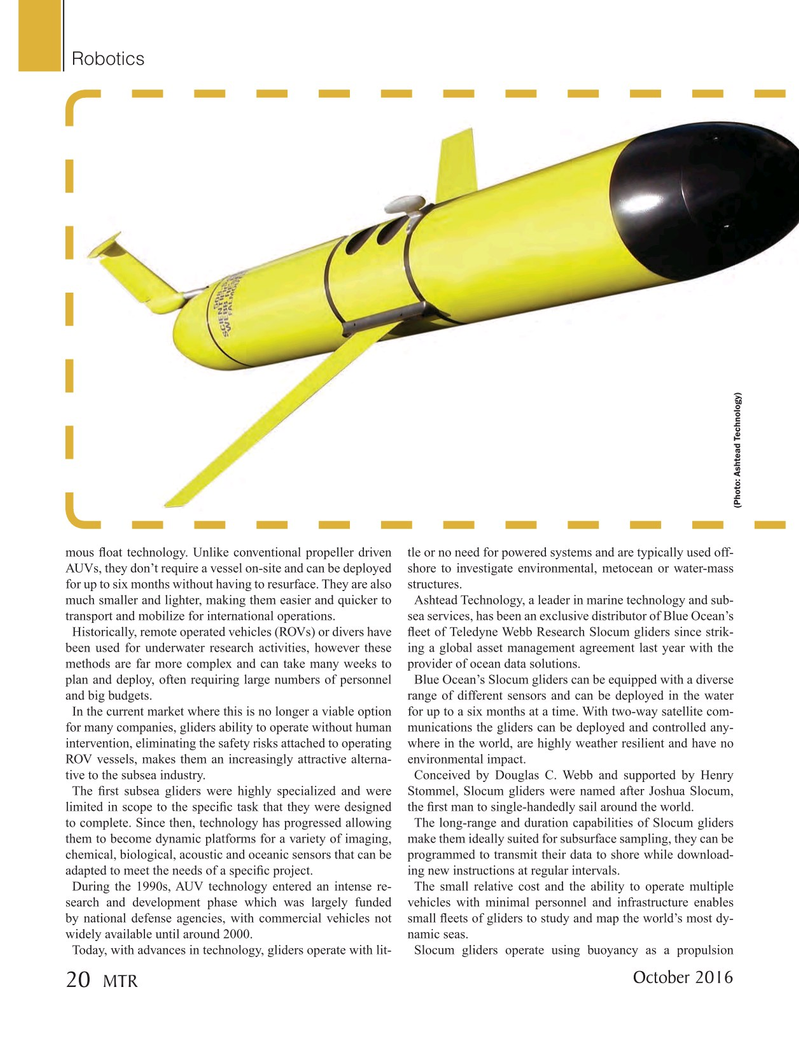
Page 20: of Marine Technology Magazine (October 2016)
AUV Operations
Read this page in Pdf, Flash or Html5 edition of October 2016 Marine Technology Magazine
Robotics (Photo: Ashtead Technology) mous ? oat technology. Unlike conventional propeller driven tle or no need for powered systems and are typically used off-
AUVs, they don’t require a vessel on-site and can be deployed shore to investigate environmental, metocean or water-mass for up to six months without having to resurface. They are also structures.
much smaller and lighter, making them easier and quicker to Ashtead Technology, a leader in marine technology and sub- transport and mobilize for international operations. sea services, has been an exclusive distributor of Blue Ocean’s
Historically, remote operated vehicles (ROVs) or divers have ? eet of Teledyne Webb Research Slocum gliders since strik- been used for underwater research activities, however these ing a global asset management agreement last year with the methods are far more complex and can take many weeks to provider of ocean data solutions.
plan and deploy, often requiring large numbers of personnel Blue Ocean’s Slocum gliders can be equipped with a diverse and big budgets. range of different sensors and can be deployed in the water
In the current market where this is no longer a viable option for up to a six months at a time. With two-way satellite com- for many companies, gliders ability to operate without human munications the gliders can be deployed and controlled any- intervention, eliminating the safety risks attached to operating where in the world, are highly weather resilient and have no
ROV vessels, makes them an increasingly attractive alterna- environmental impact.
tive to the subsea industry. Conceived by Douglas C. Webb and supported by Henry
The ? rst subsea gliders were highly specialized and were Stommel, Slocum gliders were named after Joshua Slocum, limited in scope to the speci? c task that they were designed the ? rst man to single-handedly sail around the world.
to complete. Since then, technology has progressed allowing The long-range and duration capabilities of Slocum gliders them to become dynamic platforms for a variety of imaging, make them ideally suited for subsurface sampling, they can be chemical, biological, acoustic and oceanic sensors that can be programmed to transmit their data to shore while download- adapted to meet the needs of a speci? c project. ing new instructions at regular intervals.
During the 1990s, AUV technology entered an intense re- The small relative cost and the ability to operate multiple search and development phase which was largely funded vehicles with minimal personnel and infrastructure enables by national defense agencies, with commercial vehicles not small ? eets of gliders to study and map the world’s most dy- widely available until around 2000. namic seas.
Today, with advances in technology, gliders operate with lit- Slocum gliders operate using buoyancy as a propulsion
October 2016 20
MTR
MTR #8 (18-33).indd 20 9/27/2016 1:47:22 PM

 19
19

 21
21
